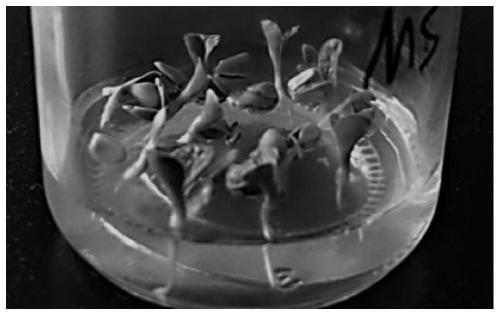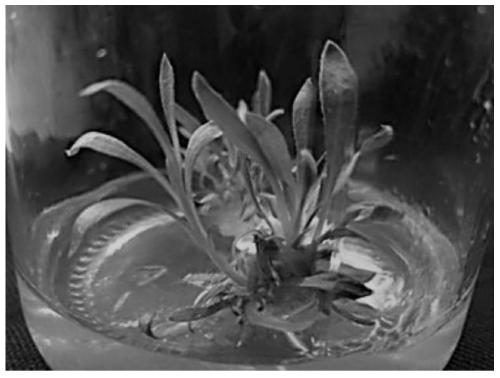A kind of rapid propagation method of safflower tissue
A safflower, fast technology, applied in horticultural methods, botanical equipment and methods, plant regeneration, etc., can solve the problem of not obtaining good germination rate and rooting effect, unsatisfactory callus germination rate, unsatisfactory callus rate, etc. problems, to achieve good multiplication multiples, easy industrial operation, and good elasticity.
- Summary
- Abstract
- Description
- Claims
- Application Information
AI Technical Summary
Problems solved by technology
Method used
Image
Examples
Embodiment 1
[0046] Example 1 Effect of Different Hormone Proportions of Safflower Stem Callus Induction Medium on Callus Rate
[0047] In order to compare the effects of different ratios of hormones in the safflower stalk callus induction medium on the safflower stalk callus rate, according to the conventional medium preparation technology in this field, the medium components were adjusted to obtain the following cultures with different components: base:
[0048] Medium 1: MS, G3251 3g / L, PVP 3g / L, NAA 1.5mg / L, 6-BA 2.0mg / L;
[0049] Medium 2: MS, G3251 3g / L, PVP 3g / L, NAA 1.8mg / L, 6-BA 2.0mg / L;
[0050] Medium 3: MS, G3251 3g / L, PVP 3g / L, NAA 2.0mg / L, 6-BA 2.0mg / L;
[0051] Medium 4: MS, G3251 3g / L, PVP 3g / L, NAA 1.5mg / L, 6-BA 2.5mg / L;
[0052] Medium 5: MS, G3251 3g / L, PVP 3g / L, NAA 1.8mg / L, 6-BA 2.5mg / L;
[0053] Medium 6: MS, G3251 3g / L, PVP 3g / L, NAA 2.0mg / L, 6-BA 2.5mg / L;
[0054] Medium 7: MS, G3251 3g / L, PVP 3g / L, NAA 1.5mg / L, 6-BA 3.0mg / L;
[0055] Medium 8: MS, G3251 3g / L,...
Embodiment 2
[0064] Example 2: Effects of Different Hormone Proportions of Redifferentiation Subculture Medium on Differentiated Plantlets
[0065] In order to compare the effects of different ratios of hormones in the redifferentiation subculture medium on the differentiated seedlings, according to the conventional medium preparation technology in this field, the medium components were adjusted to obtain the following medium with different components:
[0066] Medium 10: MS, G3251 3g / L, PVP 3g / L, NAA 3.0mg / L, 6-BA 0.1mg / L;
[0067] Medium 11: MS, G3251 3g / L, PVP 3g / L, NAA 4.0mg / L, 6-BA 0.1mg / L;
[0068] Medium 12: MS, G3251 3g / L, PVP 3g / L, NAA 5.0mg / L, 6-BA 0.1mg / L;
[0069] Medium 13: MS, G3251 3g / L, PVP 3g / L, NAA 3.0mg / L, 6-BA 0.15mg / L;
[0070] Medium 14: MS, G3251 3g / L, PVP 3g / L, NAA 4.0mg / L, 6-BA 0.15mg / L;
[0071] Medium 15: MS, G3251 3g / L, PVP 3g / L, NAA 5.0mg / L, 6-BA 0.15mg / L;
[0072] Medium 16: MS, G3251 3g / L, PVP 3g / L, NAA 3.0mg / L, 6-BA 0.2mg / L;
[0073] Medium 17: MS, G325...
Embodiment 3
[0080] Embodiment 3: rooting and domestication transplanting of differentiated seedlings
[0081] Under aseptic conditions, the adventitious shoots obtained in medium 14 were cut off the callus cells and inserted into the rooting medium. There were 20 adventitious shoots used in the experiment. The rooting medium was: MS+indole acetic acid (IBA )0.12mg / L+3g / LG3251+3g / L PVP, pH: 5.75. Culture conditions: temperature 25°C, light intensity: 4000lx, light time 16h / d, aseptic culture in light incubator, and count the rooting rate. Above-mentioned 20 adventitious seedlings all grow adventitious root, and its rooting rate reaches 100%, as Figure 4 shown.
[0082] When the above-mentioned 20 adventitious seedlings were cultivated to 5-10 cm in the rooting medium, the tissue cultured seedlings (that is, the seedlings with adventitious roots) were carried out indoor seedling hardening. The seedling hardening temperature was 26 ° C, and the light intensity was 8500 lx. 16h / d, indoor ...
PUM
 Login to View More
Login to View More Abstract
Description
Claims
Application Information
 Login to View More
Login to View More - R&D
- Intellectual Property
- Life Sciences
- Materials
- Tech Scout
- Unparalleled Data Quality
- Higher Quality Content
- 60% Fewer Hallucinations
Browse by: Latest US Patents, China's latest patents, Technical Efficacy Thesaurus, Application Domain, Technology Topic, Popular Technical Reports.
© 2025 PatSnap. All rights reserved.Legal|Privacy policy|Modern Slavery Act Transparency Statement|Sitemap|About US| Contact US: help@patsnap.com



